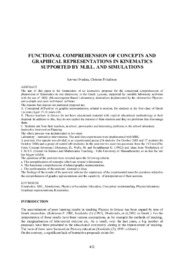| dc.contributor.author | Ovadias, Savvas | en |
| dc.contributor.author | Trikalinos, Christos | en |
| dc.coverage.spatial | CY - Λευκωσία | en |
| dc.creator | Ovadias, Savvas | en |
| dc.creator | Trikalinos, Christos | en |
| dc.date.accessioned | 2016-02-03T07:03:12Z | |
| dc.date.available | 2016-02-03T07:03:12Z | |
| dc.date.issued | 2007 | |
| dc.identifier.uri | http://hdl.handle.net/10797/14576 | en |
| dc.description | Περιέχει το πλήρες κείμενο | el |
| dc.description.abstract | The aim of this paper is the formulation of an instructive proposal for the conceptual comprehension of
phenomena of Kinematics in one dimension, in the Greek Lyceum, supported by: suitable laboratory activities
with the use of MBL (Microcomputer-Based Laboratory), simulations implemented by the «Interactive Physics»
and a simple and open web-based software
The reasons that impose our particular proposal are:
. Conceptual difficulties on graphic representations, related to motion, for students at the first class of Greek
Lyceum (Aged 15-16 years old).
B. Physics teachers in Greece do not have educational material with explicit educational methodology at their
disposal. In addition to this, they do not exploit the interest of their students and they set problems that discourage
them.
C. Students ask from their teachers, at school, provocative and interesting problems in the school laboratory.
Instructive intervention Planning
The whole process was implemented in two steps
Laboratory - instructive interventions. The activities-experiments were implemented with MBL
A post-test. Our sample was divided in an experimental group (24 students for October 2005 and 27 students for
October 2006) and a group of control (40 students). In the post-test we used two questions from the FCI test (The
Force Concept Inventory) (Hestenes, D., Wells, M. and Swackhamer G. (1992)) and ideas from Worksheets of
C.M.S.T. (Center for Science and Mathematics Teaching - Tufts University of Massachusetts), so as that the test
has bigger validity.
The questions of the post-test were selected upon the following criteria:
a. The comprehension of concepts which are related to kinematics.
b. The functional comprehension of related graphic representations.
c. The confrontation of the students’ alternative ideas.
The findings of the results of the post-test indicate the supremacy of the experimental team for questions related to
the comprehension of graphic representations and the capability of interpretation of their answers. | en |
| dc.language.iso | eng | en |
| dc.publisher | University of Cyprus | en |
| dc.relation.ispartof | Physics, Chemistry and Biology education | en |
| dc.rights | info:eu-repo/semantics/openAccess | en |
| dc.rights | Open Access | en |
| dc.source | CBLIS Conference Proceedings 2007 Contemporary Perspective on new technologies in science and education | en |
| dc.title | Functional comprehension of concepts and Graphical representations in kinematics Supported by M.B.l. and simulations | en |
| dc.type | info:eu-repo/semantics/conferenceObject | en |
| dc.subject.uncontrolledterm | Kinematics | en |
| dc.subject.uncontrolledterm | MBL | en |
| dc.subject.uncontrolledterm | Simulation | en |
| dc.subject.uncontrolledterm | Physics in Secondary Education | en |
| dc.subject.uncontrolledterm | Conceptual understanding | en |
| dc.subject.uncontrolledterm | Physics laboratory Graphical representations | en |
| dc.subject.uncontrolledterm | Kinematics | en |
| dc.contributor.conferenceorganizer | Learning in Science Group, University of Cyprus | en |
| dc.contributor.coordinator | Constantinou, Constantinos P. | en |
